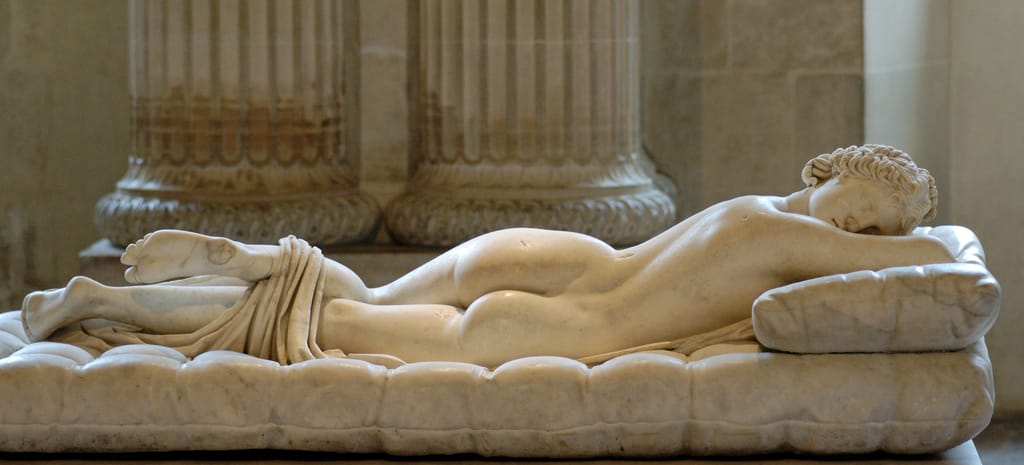Bernini’s Sleeping Hermaphroditus
The Borghese Sleeping Hermaphroditus is an iconic marble sculpture commissioned by Cardinal Scipione Borghese (hence its name) in the early 17th century. The artwork, created by the Italian Baroque sculptor Gian Lorenzo Bernini, is widely recognized for its artistry and has had a significant influence on the development of Western art.

Artistic Influence
We believe the Sleeping Hermaphroditus to be a representation of the Greek mythological figure of the same name. This figure, who was born with both male and female sex organs, represents the union of opposites and the balance of nature. By creating a sculpture of this figure, Bernini could capture the concept of duality and union, making it a powerful symbol of harmony. The sculpture itself is highly detailed and shows a great skill and craftsmanship. Bernini could capture a sense of tranquility in the sleeping figure, while also rendering its delicate features with an impressive level of realism.
In addition, the artist masterfully incorporated the sculpture’s base into the overall composition, creating a unified and harmonious composition. The influence of the Borghese Sleeping Hermaphroditus is clear in many works of art from subsequent periods. Artists have been inspired by the sculpture’s graceful beauty and have used it as a source of inspiration for their own creations.
For example, the French artist Jean-Honoré Fragonard created a painting of the same figure, entitled The Dream, which is believed to have been inspired by Bernini’s sculpture. The Borghese Sleeping Hermaphroditus has also had an influence on the development of Neo-Classical sculpture. The sculpture’s graceful form, combined with its focus on harmony, has been adopted by many later sculptors.
Similarly, the sculpture’s delicate details and lifelike realism have been emulated in a variety of Neo-Classical sculptures.
Exploring the Gender Roles
The sculpture is a representation of a mythical being—a hermaphrodite—which has both male and female characteristics. It depicts a reclined hermaphrodite, with the body of a woman and the facial features of a man. The figure is shown in a state of deep sleep, with its eyes closed and arms crossed. The sculptor draped the body in a cloth and the figure’s long hair cascades down its back. The hermaphrodite’s gender is ambiguous, yet the sculpture itself is highly evocative of the female form. The sculpture offers an interesting exploration of gender roles in the Baroque period.
The representation of a hermaphrodite blurs the boundaries between male and female and challenges the traditional view of gender roles. The sculpture suggests that gender is not a fixed concept but a fluid and malleable one. The hermaphrodite’s ambiguous body and facial features reflect the idea that gender is not determined by physical characteristics but is instead a social construct.
The sculpture has been seen as a critique of the way gender roles were viewed and enforced during Bernini’s time. The hermaphrodite’s sleeping posture has also been interpreted as a commentary on the limitations and expectations placed on women during the period. By depicting a figure that is both male and female, Bernini challenges the rigid gender roles of the time and suggests that gender should not be used to limit or oppress individuals.
The Borghese Sleeping Hermaphroditus is an important representation of Bernini’s exploration of gender roles in the Baroque period. By depicting a sleeping hermaphrodite, Bernini challenges traditional views of gender and suggests that gender is a fluid concept. The sculpture offers an interesting commentary on the social expectations and limitations placed on women during the period and suggests that gender should not be used to limit or oppress individuals.
Conclusion
The analysis of the Borghese Sleeping Hermaphroditus provides an excellent example of the evolution of Greek sculpture and of the changing tastes of artists and patrons during the Renaissance period. The sculpture is a stunning example of the skill and craftsmanship of the period, and its artistic value remains to this day. Its classical subject and its timeless beauty make it a timeless masterpiece of art, worthy of admiration and study.
Reference
- Gallery, B. (2022, December 29). Sleeping Hermaphroditus: ancient marble sculpture from the 2nd AD. Galerie Borghèse. https://borghese.gallery/collection/sculpture/sleeping-hermaphroditus.html
- McDermon, D. (2016, June 24). What the Sleeping Hermaphrodite Tells Us About Art, Sex and Good Taste. The New York Times. https://www.nytimes.com/interactive/2016/06/27/arts/design/statue-hermaphrodite.html
- Wikipedia contributors. (2023, January 22). Sleeping Hermaphroditus. Wikipedia. https://en.wikipedia.org/wiki/Sleeping_Hermaphroditus